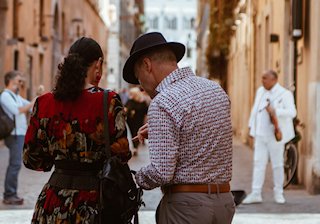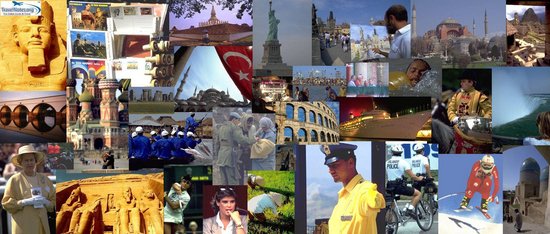Travel Notes: Destinations: South America: Colombia - Bogotá Travel Guide.
Short URL: https://tnot.es/BOG
Travel Guide For Visitors to Bogotá
Bogotá sprawls across a high plateau where colonial churches stand close to gleaming skyscrapers and street art transforms concrete walls into canvases. Share on Facebook
Second_Headline
At 2,640 metres above sea level in the Northern Andes, Bogotá showcases a striking contrast between the old and the new. This blend of historic architecture and modern urban development is a defining feature of the cityscape.
 Add a Business -
Add a Location -
Add a Lodging - Add Travel Content
- Add URL
- Travel Services.
Add a Business -
Add a Location -
Add a Lodging - Add Travel Content
- Add URL
- Travel Services.
Bogotá - Not Something You Might Expect
At such an altitude, Bogotá isn't the Colombia you might expect.
I's cooler, grittier, and infinitely more complex than the postcard-perfect coastal towns that grab all the headlines.
Bogotá is the capital of Colombia, a misty city hidden at almost 9,000 feet above sea level in the Northern Andes, and it's precisely this altitude that gives the city its distinctive character.
Morning mist clings to the Andean peaks that frame the horizon, creating an atmospheric backdrop that shifts from emerald green to pewter grey throughout the day.
Bogotá Deserves Your Attention
Most visitors to Colombia bypass Bogotá completely, heading instead for the popular coastal town of Cartagena, or Medellin, but this couldn't be more misguided.
The capital offers something its more touristy siblings can't match: authenticity.
This is where real Colombian life unfolds, where political decisions are made, and where the country's cultural pulse beats strongest.
Museums and Landscape Drama
The city houses more than 50 museums, including the world-renowned Gold Museum; whilst some dramatic scenery (it's at the bottom of two mountains with a church on top of each) provides a stunning natural amphitheatre.
The street art scene here rivals anything in Berlin or Buenos Aires, and the dining landscape has evolved into something genuinely exciting.
Essential Bogotá Attractions
La Candelaria - The Historic Heart
The historic quarter of La Candelaria unfolds like a living museum, where colonial churches and cobblestone walkways share the space with high-rises.
This isn't some sanitised tourist enclave, it's a working neighbourhood where elderly residents emerge from doorways painted in primary colours, university students debate politics in pocket-sized plazas, and the scent of freshly ground coffee mingles with exhaust fumes.
The narrow streets climb and dip with the terrain, revealing hidden courtyards, tiny galleries, and cafés that look as though they haven't changed since the 1960s.
It's here you'll find some of the city's most important cultural institutions, including the Botero Museum (Cl. 11 #4-41) and the Casa de Nariño (Presidential Palace).
Monserrate - Views and Spirituality
Panoramic city vistas await atop a scenic funicular or cable car ride to Monserrate, the mountain sanctuary that watches over Bogotá.
At 3,152 metres, the journey upward reveals the city's true scale; a sprawling metropolis of eight million people that seems to stretch endlessly across the plateau.
The sanctuary itself combines Catholic pilgrimage site with tourist attraction, complete with restaurants, souvenir shops, and walking trails.
However, it's the view that draws most visitors.
On clear days, you can see across the entire Sabana de Bogotá, with the city's business district glittering below and the Andes rising dramatically in the distance.
Museo del Oro - Pre-Columbian Treasures
The Gold Museum stands as one of South America's most significant cultural institutions, housing some interesting artifacts dating back to pre-Hispanic times.
The collection transcends mere display, it tells the story of indigenous Colombian cultures through thousands of gold objects, ceramics, and textiles that predate European colonisation.
The museum's circular room, where golden artifacts seem to float in darkness, creates an almost otherworldly experience.
It's particularly striking when you consider that many of these pieces were created by cultures that viewed gold not as currency but as a sacred material representing the sun itself.
Where to Stay in Bogota - Neighbourhoods to Consider
Each neighbourhood offers a unique slice of Bogotá, so your choice depends on whether you prioritise history, nightlife, or a more local experience.
Like any large city, Bogotá has areas that are safer than others.
La Candelaria and Chapinero are generally considered good choices for tourists, balancing safety and convenience.
Bogotá is vast, so consider proximity to TransMilenio (the city’s rapid bus system) or main roads for easier travel.
If you enjoy mingling with locals and your Spanish is decent, Chapinero and La Macarena are excellent for a more authentic experience.
Chapinero
Chapinero is a diverse and trendy district, popular with both locals and expats.
It’s known for its excellent restaurants, cafés, and nightlife, as well as being LGBTQ+ friendly.
This area offers a good balance between local life and modern comforts, making it a favourite for travellers who want to experience Bogotá beyond the tourist trail.
It’s also considered one of the safer and more dynamic parts of the city.
La Candelaria
If you’re keen on history, culture, and a bohemian vibe, La Candelaria is the heart of Bogotá’s old town.
This is where you’ll find the colourful colonial buildings, museums, and vibrant street art.
It’s ideal for first-time visitors who want to be within walking distance of major sights like the Gold Museum and Plaza Bolívar.
However, do be mindful that while it’s lively during the day, it can be quieter at night, so take usual city precautions.
La Macarena & Teusaquillo
For a more laid-back, artsy atmosphere, La Macarena is a small neighbourhood with a strong creative scene, great restaurants, and a local feel.
Teusaquillo, meanwhile, offers a quieter, residential vibe with beautiful parks and a glimpse into everyday life in Bogotá.
Zona Rosa (Zona T) & Parque 93
If you prefer a more upscale experience, Zona Rosa (Zona T) and the nearby Parque 93 area are known for their luxury hotels, shopping, and vibrant nightlife.
These neighbourhoods are modern, safe, and bustling; perfect if you enjoy being in the centre of the action and want easy access to Bogotá’s best bars and clubs.
Tourist Map of Bogota
Use the Tourist Map of Bogota to help you decide where to stay in Bogota based on travel budget, preferred location, planned must-see attractions and local must-do activities.
Bogotá's Food Scene - A Culinary Revolution
The Colombian capital has undergone a remarkable gastronomic transformation in recent years.
Street Food and Local Specialties
Beyond the high-end establishments, Bogotá's street food scene offers authentic flavours at pocket-friendly prices.
You may be familiar with hot chocolate, but have you ever had it with cheese?
In Bogotá, you can try a version made with blocks of chocolate melted in water or milk and then mixed in with a mildly salted cheese; a combination that sounds bizarre but works brilliantly.
Paloquemao
The city's markets, particularly Paloquemao (Av. Calle 19 No. 25-04), provide insight into Colombian gastronomy's roots.
Here, exotic fruits sit alongside traditional ingredients, whilst small comedores serve hearty meals to market workers and adventurous visitors alike.
World-Class Dining
Bogotá is filled with amazing restaurants that represent world cuisines beyond the traditional Colombian fare; creating a dining landscape that surprises even seasoned food lovers.
El Chatto
El Chato (Cl. 65 #4-76) has appeared on the 'World's 50 Best Restaurants' list, signalling Bogotá's emergence as a serious culinary destination.
This isn't an isolated success story; the city now boasts numerous establishments that would feel at home in London or New York.
Harry Sasson
Harry Sasson (Cra. 9 #75-70), a restaurant that has garnered a deserved reputation as one of the city's best, exemplifies the city's fine dining scene.
The restaurant's three distinct dining rooms offer everything from intimate dinners to grand celebrations, with a menu that elevates Colombian ingredients through international techniques.
Cultural Experiences and Nightlife
Culture
Lively experimental theatres stand alongside some of the most exciting museums in the Americas, creating a cultural landscape that rivals any major world city.
The Luis Ángel Arango Library (Cl. 11 #4-14) regularly hosts world-class exhibitions, whilst smaller venues throughout the city showcase emerging local artists.
Nightlife
The nightlife varies dramatically by neighbourhood.
Zona Rosa attracts a more upscale crowd with its cocktail bars and international restaurants, whilst areas like Chapinero offer everything from underground clubs to intimate jazz venues.
The city's altitude means alcohol hits harder than usual, so pace yourself accordingly.
Practical Information for Visitors
Day Trips from Bogotá
Bogotá offers a variety of easy day trips that get you out into nature; with hiking, rock climbing and a surprising theme park.
Salt Cathedral of Zipaquirá
The Salt Cathedral of Zipaquirá, carved into a functioning salt mine, makes for an extraordinary day trip.
Villa de Leyva
The colonial town of Villa de Leyva, north-east of Bogotá, is known for its whitewashed colonial buildings, cobbled lanes, vast Plaza Mayor, and weekend markets.
Getting Around
Bogotá's TransMilenio bus system, despite its reputation for overcrowding, remains the most efficient way to traverse the city.
Various transportation options are available for visiting the Salt Cathedral from Bogotá.
Taxis and ride-sharing services like Uber operate throughout the city, though traffic can be brutal during rush hours.
Bike Sharing in Bogota
The city's bike-sharing system, Bici Bogotá, offers an eco-friendly alternative for shorter distances.
Weather and When to Visit
The city's high altitude means temperatures remain relatively stable year-round, typically ranging from 8°C to 20°C.
However, the weather can change rapidly. Pack layers and always carry a waterproof jacket.
The dry season (December to March) offers the best weather conditions, though this coincides with peak tourist season.
Festivals and Events
In March, you'll be able to check out the Estéreo Picnic Music Festival, Colombia's biggest alternative music festival, and one of the most recognised across South America.
The city's cultural calendar extends well beyond music, with the International Jazz Festival drawing world-class performers each autumn.
In terms of national holidays, December is a festive time to visit and, if your trip coincides, make sure to explore the Festival of Lights in Villa de Leyva, though this requires a day trip from the capital.
Bogota is Rewarding
Bogotá rewards the curious travelller.
It's not a city that reveals its secrets immediately; the traffic is maddening, the weather unpredictable, and the altitude takes adjustment.
Yet beneath this challenging exterior lies a metropolis of incredible depth, where every neighbourhood tells a different story and every meal might surprise you.
The city's transformation from a place visitors endured to one they actively seek out reflects broader changes in Colombia itself.
This isn't the dangerous, unstable country of international headlines; it's a nation confidently looking towards the future whilst honouring its complex past.
Whether you're drawn by the world-class museums, the emerging culinary scene, or the sheer urban energy of eight million people living at the roof of the world, Bogotá offers experiences you won't find anywhere else in South America.
It's a city that challenges preconceptions and rewards patience; exactly what every great travel destination should do.
More City Travel Guides
City Guides: Cities in Africa - Cities in America - Cities in Asia - Cities in Australasia - Cities in Latin America - European Cities and Regions.
More From Travel Notes
Travel Notes Online Guide to Travel
Africa - Asia - Caribbean - Europe - Middle East - North America - Oceania - South America.
The Travel Notes Online Guide to Travel helps visitors plan their trip with country and city travel guides, local tourist information, reviewed web sites, and inspiring travel content.
Travel and Tourism Guides on Travel Notes
 If you find Travel Notes useful, please take a moment to
like us on Facebook and share with your friends on social media.
If you find Travel Notes useful, please take a moment to
like us on Facebook and share with your friends on social media.
Share on Facebook
Travel Resources
.
Travel & Tourism With Industry Professionals.


















